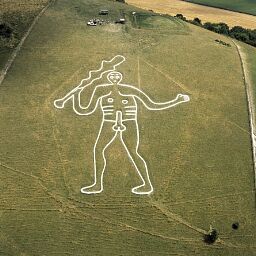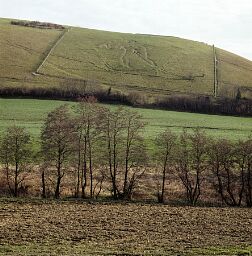If you have any comments or new information about this record, please email us.
| NT HBSMR Number: | 110511 |
|---|
| Type of Record: | Monument |
|---|
| Name: | Hill Figure, Cerne Giant |
|---|
Summary
The Cerne Giant is a turf-cut figure on the south-west end of Giant Hill. It represents a nude man striding towards the left, he holds a knotted club in the right hand and has the left arm stretched out.
| Grid Reference: | ST 666 016 |
|---|
| Civil Parish: | Cerne Abbas; West Dorset; Dorset |
|---|
| County: | Dorset |
|---|
| District: | West Dorset; Dorset |
|---|
| NT Property: | Cerne Giant; South West |
|---|
| Map: |
All our Monument records are mapped in
NT Heritage Records Online.
|
|---|
Protected Status
- Scheduled Monument 1003202: CERNE GIANT
Other References/Statuses
- Area of Outstanding Natural Beauty
- National Monuments Record Reference: ST60SE39
- Site of Special Scientific Interest (Biological)
Monument Types
Full description
The Giant is a figure cut into the turf to expose a white chalk outline. It is almost 60 metres tall and brandishes a club 40 metres long. It represents a nude figure striding towards the left; he holds a knotted club in the right hand and has the left arm stretched out; the nipples and ribs are badly represented as is the phallus. The figure, according to Hutchins ( History of Dorset, 1774), had letters or figures between the legs of doubtful significance and date. Whether the outstreched left arm originally carried a lion skin or cloak is open to debate, resitivity surveys have revealled traces of cutting into the chalk in this area.
The giant's origin is uncertain and three arguements for a potential date have developed. The first faction, citing lack of documentary evidence in the medieval period for the figure, date the Giant to the seventeenth or eighteenth century. If this is the case the Giant is another gentleman's folly; but there is evidence that contradicts the above, 'this figure has been reported to have been made by Lord Holles's servants, during his residence here, but it is more likely that he only caused it to be repaired; for some people who died not long before 1772, 80 or 90 years old, when young, knew some of the same age that averred it was there before the memory of man' ( Hutchins 1774). This is important as this appears to date the Giant to at least the early seventeenth century. There is also evidence that in the medieval period the Giant was referred to as Helis ( W. Stukeley, Minute Books, Soc. of Antiq., 1764).
The second faction believe the Giant to be of Romano-British date. They argue that the Giant closely resembles representations of the Roman hero-god Hercules, who was derived from the Greek hero Heracles, although the evidence of stylistic comparison is flimsy.
The third faction believe the Giant is of Celtic origin. They compare the Giant stylistically to a representation of a Celtic god on a a skillet handle found at Hod Hill, Dorset. The handle almost certainly dates from between AD 10 to AD 51. From this the theory is put foward that the Giant dates approximately the same period as the handle and was made by the Durotriges to represent a god of fertility and hunting. However the recent optical dating of the Uffington White Horse to the late Bronze Age may force a revision of this Iron Age date to an earlier one in prehistory.
His body is outlined and detailed by narrow trenches no more than 0.60 metres wide, and his condition has been maintained by periodic scouring by the local people, an activity which traditionally occurred at long intervals. Gerald Pitman of Sherborne has carefully chronicled the history of the Giant, and has records of scourings in 1694, 1868 and 1887, when the fence was placed around the figure. There are records of five scourings this century at intervals ranging from eleven to twenty-three years. During that of 1908, the Giant's navel, which by then must have become almost completely obscure, appears to have been incorporated into his phallus. However, there is now no clear record of what his condition was when the property was given to the National Trust in 1920 by Alexander and George Pitt-Rivers, although this was the year that Flinders Petrie carried out his survey of the Giant. The gift to the Trust was endowed by Henry Hoare of Stourhead, Wiltshire in 1924.
In March 2020, National Trust archaeologists excavated four small trenches across the upper elbow lines and lower foot lines of the Cerne Abbas Giant. Each 2m long and 0.6m wide. They were excavated to extract soil samples to carry out molluscan and soil analysis but principally to provide Optically Stimulated Luminescence dates to determine the age of the chalk figure.
Each excavation revealed the same sequence of events and the locations were chosen because heavy rain on the steep slope of the hill causes chalk run-off from the exposed white lines of the figure. This process causes the accumulation of silts against the horizontal parts of the outline, that is, in places like the soles of the Giant’s feet and his outstretched arm and elbows.
At these points, the various re-chalkings of the Giant have gradually become buried over time, accumulating deposits up to 0.8m deep below the current chalk-line surface of the figure.
Ten episodes of chalk figure construction could be seen in the excavation sections and each had a different quality. At the lowest level was the initial 0.15m deep and 0.65m wide curving hollowed scoop into the chalk bedrock which had become filled with colluvium. This was later cut through by a 0.35m wide trench filled with chalk rubble up to 0.35m deep. Above this a soft chalk paste up to 0.05m deep and above this a soft pea-grit chalk 0.0.05m deep, then another but smaller chalk rubble layer up to 0.3m deep, above this two episodes of kibbled chalk dating from the 1950s and 1960s, together up to 0.3m deep, and then three episodes of rammed compacted chalk, together 0.3m deep, dating from 1980s to 2019 when the last re-chalking was carried out by National Trust.
In 2020, the modern 0.4m wide line of the figure was found to have shifted up to 0.3m downslope compared with the position of the lowest 0.35m wide chalk rubble layer.
In three of the trenches, remains of timber paling stakes were found rammed into the outer edge of the chalk outline. Two were truncated at the upper rubble chalk layer but the one in the right foot of the Giant (north) was 0.55m long and survived from the upper kibbled chalk layer to the bottom of the lower chalk rubble layer. It suggests that the whole figure was marked out by wooden stakes at some time probably in the late 19th or early 20th century.
Mike Allen has examined molluscan samples from the lowest colluvium which filled the initial scrape into the bedrock and his initial assessment is that there are species present which were only introduced in the medieval period.
In March 2021 the OSL report was received which provided 4 dates from the 5 samples which were analysed. The sample from the 0.05m wide silty chalk layer had insufficient quartz samples to provide a date. A sample from the downslope side of the figure and 10cm from chalk bedrock provided a date of AD 1110-1560 with midpoint 1250; a sample upslope and 5cm from chalk bedrock was dated to AD 1080-1400 with midpoint 1240; a sample from 5cm above the bottom of the bottom chalk rubble layer, 5cm from chalk bedrock gave a date of AD 650-1310 with a midpoint date of AD 980; the lowest sample and oldest stratigraphically was from the colluvial material filling the initial scoop into chalk bedrock and this yielded a date of AD700-1110 with a midpoint date of AD 905. The report concluded that the Giant could not be older than AD 700 and there was a one sigma (66%) probability that he had been constructed in the early medieval period.
These new dates centre around the Saxon occupation of Cerne and revitalise the ideas surrounding the Saxon god Helith (favoured by William Stukely 1764) and the foundation of Cerne Abbey in AD987. If these dates are accepted then the Abbey sanctioned the continued exposure of the image of the Giant on the hill just a few hundred metres from its cloisters. However, the dates are still curious because there are no mentions of the Giant in any of the monastic documents and writings which survive from Cerne Abbey and still no historic reference to the chalk figure before the Church Wardens account repair bill of November 1694. John Norden's survey of the estate in 1617 mentions Trendle Hill but not the Giant.
The section drawings and soil accumulation needs careful examination as the initial scrape into chalk bedrock was allowed to become covered in 10-20cm of colluvial deposits before the being cut into by the 0.35m deep trench which penetrates the natural chalk and was filled with the lower chalk rubble deposit.
Sources / Further Reading
| --- | SNA64739 - Collection: National Trust. Collection of photographs related to re-chalking the Cerne Abbas Giant 1959 to 1994. |
| --- | SZN13271 - Photograph - colour: Martin Papworth. 01/06/1994. Meeting to Discuss Whether to Uncover the Cloak Indicated by Resistivity Survey. |
| --- | SZN14104 - Photograph - colour: Martin Papworth. 01/04/1993. Cerne Abbas Giant's Head before Raising the Nose. 2M/0.5M INT.. |
| --- | SZN1615 - Monograph: J Hutchins. 1774. The History and Antiquities of the County of Dorset. 1. |
| --- | SZN16753 - Photograph - colour: David W R Thackray. 01/01/1980. Close up of the Cerne Giant Information Panel.. |
| --- | SZN22421 - Photograph - colour: Martin Papworth. 01/04/1993. Cerne Abbas Giant's Head before Raising the Nose. 2M/0.5M INT.. |
| --- | SZN23400 - Photograph - colour: David W R Thackray. 01/01/1980. Close up of cloak/ lion-skin. The additional outline of the "lion-skin" was made by applying a light. |
| --- | SZN27097 - Photograph - colour: Martin Papworth. 01/04/1993. Cerne Abbas Giant's Head before Raising the Nose. 2M/0.5M INT.. |
| --- | SZN35303 - Photograph - colour: David W R Thackray. 01/01/1980. Information Panel with the Giant in the background.. |
| --- | SZN36401 - Photograph - colour: Martin Papworth. 01/04/1993. Cerne Abbas Giant Viewed from the Main Road North of the Village. |
| --- | SZN36402 - Photograph - colour: Martin Papworth. 01/04/1993. Cerne Abbas Giant's Head before Raising the Nose. 2M/0.5M INT.. |
| --- | SZN39551 - Photograph - colour: David W R Thackray. 01/01/1980. View from lay-by showing the position of the Information Panel.. |
| --- | SZN44302 - Photograph - colour: David W R Thackray. 01/01/1980. The figure after restoration, with the extended fence and grazed by sheep.. |
| --- | SZN46903 - Photograph - colour: David W R Thackray. 01/01/1980. Outline of the Giant showing an additional outline on the left arm, revealed by resistivity survey. . |
| --- | SZN47069 - Photograph - colour: Martin Papworth. 01/04/1993. Head of Giant after Raising the Nose. 2M/0.5M INT.. |
| --- | SZN7037 - Article in serial: W Stukeley. 1764. Minute Books. 9. |
Associated Finds: none recorded
Associated Events: none recorded
Related records: none recorded
Images
All full size images can be viewed in
NT Heritage Records Online.
 Hill Figure, Cerne Abbas Giant © National Trust |  View of the Cerne Giant cut into the chalk, Cerne Giant © National Trust |
Search results generated by the HBSMR Gateway from exeGesIS SDM Ltd.